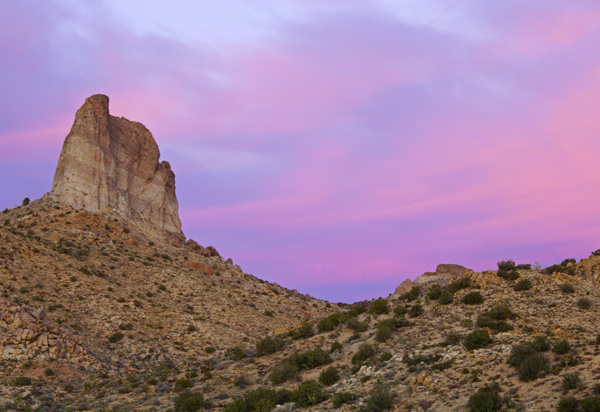
I’m used to dealing with some light 15 mph winds when photographing wildflowers, but this 60 mph stuff was strong enough to start shaking my tripod. So, I had to think quickly about how to keep my camera still and come away with a sharp photo of the beautiful sunset that was approaching.
Here are a few things I came up with to ensure I got an acceptably sharp photo:
#1 – Use a wider aperture than normal
Using a wider aperture will help you get a faster shutter speed, which means your camera will have less time to be affected by camera shake from the wind. For the photo above, I would have typically used f/11, but with the high winds, I shot the scene at f/8. I was pretty far away with a long lens (my 70-200mm), so f/8 still gave me enough depth of field.
#2 – Use a higher ISO than normal
Another thing you can do to get a faster shutter speed is increase your ISO speed. Most cameras these days work pretty well up to ISO 400 or 800 before you can notice any big changes in image quality, so don’t be afraid to use those higher ISOs even for landscape photos!
#3 – Avoid using your tripod’s center column
That center column of your tripod is extremely unstable, so in high winds your camera will bounce frantically through the air when that column is extended all the way. Instead of using that center column, try looking for higher ground nearby to compensate.
#4 – Find an area that’s sheltered from the wind
Try to determine where the wind is blowing from, and then start looking for areas that may be sheltered from the wind. Trees and big rocks really help here. Remember not to compromise your composition though. An unsharp but well composed photo will almost always be better than a sharp poorly composed photograph.
#5 – Hold down your tripod
If your tripod has one of those hooks on the center column, then try hanging your camera bag from there to help stabilize it. You can also try holding down the tripod with your hands, but be extremely careful not to shake the tripod even more.
#6 – Wait for the wind to calm down
If the wind seems to be sporadic and not occurring on a consistent basis, then try to just wait for that short moment where everything is calm. You might want to turn off mirror lockup for this, so you don’t get that extra delay when releasing the shutter.
#7 – Zoom in to check sharpness
Once you snap a few shots, zoom in on your LCD preview screen to make sure you got a sharp photo. If you consistently keep getting blurry photos, then try applying the tips above more vigorously until you get a good balance between sharpness and image quality.
What did I miss?
Have you also found yourself battling some extreme wind conditions? How did you keep your camera still? Please tell us about it by leaving a comment below. Thanks!
If you enjoyed this article, and would like to read more, please signup for free updates by email or RSS.
 About the Author: Steve Berardi is a naturalist, photographer, computer scientist, and founder of PhotoNaturalist. You can usually find him hiking in the beautiful mountains and deserts of Southern California.
About the Author: Steve Berardi is a naturalist, photographer, computer scientist, and founder of PhotoNaturalist. You can usually find him hiking in the beautiful mountains and deserts of Southern California.
Hey Steve,
Great article!
I guess in this situation there is always going to be a level of compromise.
One of the great things about windy days is trying to shoot with a long exposure to get the effect of the clouds streaking through the sky, but if you are really getting hammered then best to try and speed it up so that at least you get a workably crisp image.
Thanks mate,
Richard
Great advice Steve. One other method you can try is not only to hold down your tripod, but position yourself with your back to the wind sheltering your tripod. It doesn’t block out everything, but it will cut down some of the buffeting.
Another time I was shooting wind turbines from a country road (in a strong wind) and positioned my camera at the back of my car and opened up the trunk. Reduced the wind to my camera by at least 70%.
I think also a simple but important point is to keep the tripod low by spreading the legs wide as you can. I’ve seen too many people who automatically setup the tripod right at comfortable eye level, which is often the least interesting perspective as well as being less stable in the wind.
Thanks for the useful tips!
Normally vibration reduction is turned off when shooting with the camera on a tripod. But in very high winds (>20 mph), try turning vibration reduction on.
@Richard – Great point about including the wind as an element in your shots (either with the clouds streaking across the sky, or even trees blowing in the wind and becoming a blur in the final image). I think that can work great in a lot of situations.
@Peter – Great suggestion about putting your back to the wind. That would definitely help too, as long as it doesn’t force you to compromise your composition.
@Philip – Another great tip! I didn’t think about that at all, since in the photo above I needed my camera pretty high to get above some juniper trees.
@George – Thanks for mentioning vibration reduction. I totally forgot that I did that too for the image above. It helped a ton!
Thanks for the good writeup. It in truth was once a
enjoyment account it. Look complex to far introduced agreeable from you!
By the way, how can we be in contact?